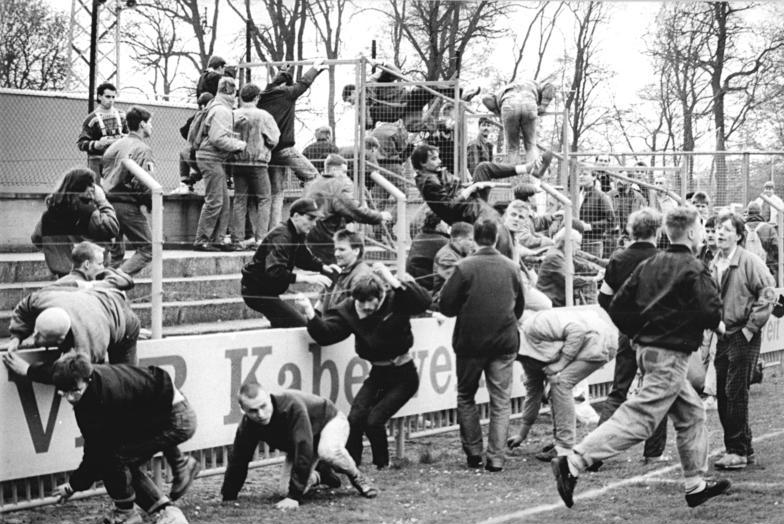Is English Football on the brink of an unwelcome renaissance?
From Margaret Thatcher’s flat out dislike of the sport and it’s fans, to Blair and Cameron’s somewhat scripted, cringe worthy support for Newcastle and Aston Villa respectively, politicians have always had a contentious, sticky relationship with our nations game. Following the high profile incidents that blighted Lady Thatcher’s premiership: Heysel, Hillsborough and the hooliganism at Italia 90’, The Iron Lady underwent a much celebrated sanitisation of the English game. Thatcher’s purge has swept the sport, hanging over the Premier League since its inception. As a result, ‘soccer terrorism’ in England is now more like a scuffle in a provincial nightclub; besmirching, but not terminal.
In recent seasons English Football has witnessed a counter offensive. Fans are fighting back against the products of this sanitisation; a process characterised by oppressive ticketing schemes, all-seated stadia and the influence of television corporations on kick-off times. In the light of recent events, it is imperative we distinguish between indiscriminate acts of violence or racism and calculated acts of protest ‘against modern Football.’ We must not paint the two with the same brush. To blur the line would be contributing to this façade, this false impression that Football is returning to the dark days of the 1980s.
In the light of recent events, it is imperative we distinguish between indiscriminate acts of violence or racism and calculated acts of protest against modern Football.
“The group was born out of anger at the repressive nature of the modern game and society as a whole, and we’ve vocally and visually conveyed these feelings since our formation.” These are the words of the Holmesdale Fanatics; Crystal Palace’s boisterous ‘ultras’, formed in 2005. The past decade has seen the emergence of several Italian-style ultra groups throughout the British Isles, formulated to boost atmospheres at otherwise mundane, duplicated stadiums. Such groups are fighting back against the threat of theatre-like spectatorship in stadiums and their collaboration with club officials is testament to their success. The general perception of Crystal Palace from the Football community has shifted from looming financial disaster to a stable Premier League club with ‘wonderful’ fans, according to ex-manager Tony Pulis. Nevertheless, a certain stigma accompanies the term ‘ultras’- underlined by a general apprehension of the mob mentality and the subversive capabilities of the collective. This apprehension is unfounded. The number of Football-related arrests at international and domestic matches involving teams from, or representing England totalled 2,456 during the 2012-2013 season, the second lowest on record. Overwhelming proof the emergence of these groups has been far from detrimental to English Football. Ultimately, ‘ultras’ are self-appointed and unfortunately, the term implies violence rather than celebrating the central role of the fans at Football clubs. This unfounded sense of panic surrounding the Football fanbase has extended to recent events at Villa Park and on the Parisian underground.
This unfounded sense of panic surrounding the Football fanbase has extended to recent events at Villa Park and on the Parisian underground.
The sickening events prior to Chelsea’s Champions League first-leg tie against Paris Saint-Germain transcended Football. David Cameron condemned the events as ‘extremely disturbing and very worrying.’ A fan-filmed video showed a group of Chelsea supporters refusing a black man entry to the train carriage amid chants of ‘we’re racist, and that’s the way we like it.’ It would be remiss, however, to suggest in light of this event that racism is football’s problem – it remains society’s problem. Sadly, racism in Football will continue to rear its ugly head until the day it is extinguished in society once and for all. Similarly, the events at Villa Park following (and during) Aston Villa’s FA cup quarter final win over local rivals West Brom do not represent the emergence of a frightening renaissance. Not in the slightest. Quite frankly, Mark Lawrenson’s assessment that “it’s like a scene from the 1980s all over again” is a gross overstatement. The argument that pitch invasions and violence between opposing fans have been consigned to the past is naïve. Parallels can be drawn between the events in Paris and in Birmingham. Both are disturbing and both justify punishment. But crucially, both are exceptional cases.
Parallels can be drawn between the events in Paris and in Birmingham. Both are disturbing and both justify punishment. But crucially, both are exceptional cases.
No one is suggesting that hooliganism has been eradicated altogether. Many would point to the horrific unprovoked attack on Watford fan Nick Cruwys outside Molineux last weekend or the resurgence of ‘firms’ more interested in organising a 4 v 4 scrap than watching their team play. But, it’s far from an exaggeration to suggest that there is far less hooliganism in Football today. On the brink of an unwelcome renaissance? Not quite.

Comments